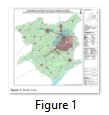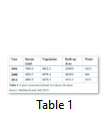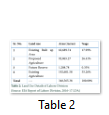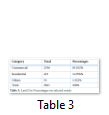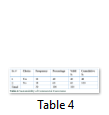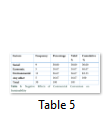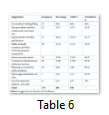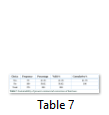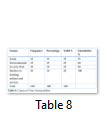Full Length Research Article
Rapid commercial conversion of agriculture land in Lahore Division, Pakistan
Imtiaz Hassan
Adv. life sci., vol. 5, no. 4, pp. 192-203, August 2018
*- Corresponding Author: Imtiaz Hassan (Email: raiimtiaz22@yahoo.com)
Author's Affiliation
Abstract![]()
Introduction
Methods
Results
Discussion
References
Abstract
Background: Pakistan is experiencing rapid population growth and urbanization which require land in urban areas. Rapid commercial conversion of has dramatically changed agriculture land base. The present conversion policy is not capable to achieve principles and objectives of sustainability especially in agriculture areas.
Methods: The methodology includes literature review and collection of data by using random systematic sampling technique. Surveys of key informants, adjoining neighbors and owners of properties were conducted in the field. The study is focused to identify the negative effects of commercial conversion of land uses; major causes of illegal conversion; major driving forces; actors behind the commercial conversion of agriculture land and profit maximization arising from increasing demand of commercial spaces, physical aging of residential building structure leading to obsolesces are the main contributing factors giving rise to commercial conversion of land uses in Lahore Division.
Results: The researcher founded that main problems of study area resulting from illegal land conversion include shortage of parking space, security risks, harassment of LDA staff, traffic congestion, environmental pollution, destruction of social life, lack of utility services, abuse of land and poor governance.
Conclusion: The commercial conversion is dimensioning agriculture land and development is taking place in piecemeal fashion. The study recommends the dire need of spatial planning, proper zoning, enforcement of value tax, sustainable commercial conversion policy, compact and mixed development policy, sustainable land use planning and development of a planning system with effective enforcement measures which itself guarantee a sustainable land use development and rational utilization of prime agriculture land.
Keywords: Commercial Conversion, Land Use, Master Planning, Local Government, Driving Forces, Driving Actors and Agriculture Zone
Cities are the dynamic engines of growth and indication of progress / transformation. According to World Cities Report 2016 P-III (Urbanization and Development Emerging Futures in UNHABITAT), cities have been primary arena where changes takes place [1]. This report indicates rapid increase in urbanization of world’s population and mentions the need of new urban agenda aimed to enhance the contribution of cities towards sustainable development.
In Pakistan, un-paralleled population growth with planned and un-planned land use conversion activities have resulted in rapid urbanization but urban areas lack infrastructure facilities to cope with rising urban population. Sustainability of urban areas of cities can be achieved by a balance between social, economic and environmental goals. Planning and management become imperative. The goal of managing land use and its change is to develop the land resources in ways that capitalize their local potential and suitability, avoid negative impacts and respond to present and future societal demand within the limits of the capacity of the local environment. Rapid urbanization gives rise to different problems including increase in urban poverty, unemployment, lack of basic necessity, burden on infrastructure, uneven distribution of people and resources, gentrification of land and commercial conversion of agriculture land rapidly, degradation of environment, deprivation of facilities, shortage of parking, traffic delay and encroachments, it also results in scattered development and reduces local resources and destroys agriculture land. Land use conversion is not specific to Pakistan only, even in most developed cities such as Los Angeles, New York etc. During the 1960s geographers attempting to classify commercial strips identified four categories of strip environments (Boal and Johnson, 1971) [2] i.e. hierarchical strips; highway-oriented strips; urban arterials; and specialized strips. In March 2014, Planning Commission in USA [3] engaged planning firms to figure out approaches to suggest the ways and plans in order to avoid the strip commercial development in USA. The consulting team identified a wide variety of methods used in comprehensive plans from other communities to discourage or repair strip commercial development.
Ross A. Moldoff [4], AICP in his Article on Controlling Strip Development suggested following approaches / steps to control Strip Development.
- Use Zoning to Prevent Future Linear Strips.
- Adopt Architectural Standards
- Use Plantings to Soften the View
- Restrict Signage
- Deal with Traffic Congestion & Pedestrian Access
- Consider a Comprehensive Ordinance for the Corridor
In USA, many local governments have imposed strict land use control due to increasing urbanization. Their efforts have been successful in slowing down development. Commercial conversion of land use is a key factor in the development of human and physical environment. It is most clearly visible result of human interaction with bio physical environment. Land use change or spatial change has a much broader meaning as it is used in variety of context reveled. Lahore Development Authority Land use Rules 2014 [5] states the conversion of land use as:
“Conversion of land use means any change in use of land or property from the one originally provided in an approved scheme or Master Plan of an area.”
There are Physical institutional, Social and economic reasons behind conversion. commercial conversion is taking place with the approval of authority under the umbrella of commercialization policies like commercialization policies 1982, 1984, 1988, 1993, 2001, 2004 [6] Punjab Land use (Classification, Re-clarification and Redevelopment) Rules 2008 [7] , Punjab Land use (Classification, Re-clarification and Redevelopment) Rules 2009 [8], and LDA Land use Rules 2014. The commercial conversion is also taking place without approval of authority. The process of illegal conversion in agriculture zone is carrying on due to lack of Law-enforcement mechanism, rapid population growth, Urbanization, Unmanageable population size, Interference of Powerful Political Politicians, mal practicing of development agencies/Institution and Insufficient legal support. In other words driving forces and actors are responsible for illegal and unplanned Commercial conversion in Lahore Division. Land use is driven by a variety of forces [9]. Driving forces are the forces that together with actors shape land change. Driving forces form a complex system of dependencies and interaction and affect a whole range of temporal and spatial levels. There are two main categories of driving forces including bio-physical and socio-economic. Burgi et al., identified five group of driving forces that are “Political”, “Economic”, “Cultural”, and “Technological” and “Natural” driving forces [10].
In developing countries, political and economic driving forces played vital role as driving forces. Rapid urbanization is also important driving force in these countries. In Pakistan, urbanization, political forces and economic driving forces are mobilizers of the commercial conversion in all cities. It has also resulted unplanned commercial areas in cities especially in agriculture belts. Actors make decision, act accordingly, and influence other actors and the environment with their actions. Actors can be individuals, agencies, and institutions, representing the whole range of organizational scales. We distinguish between two types of actors: actors that affect driving forces and actors that directly change land or convert the land use.
The term land change clearly refers to development; driving forces do not necessarily have to cause change. Driving forces can be too weak, i.e., below the threshold at which change would take place, they can have a stabilizing effect (e.g., zoning regulations), or several driving forces can operate in opposite directions. All three effects result in persistence of land [10]. Invasion and succession process is taking place in Lahore. The city centers of all districts in Lahore Division are not capable to accommodate growing needs of people and commercial activities are expanding on primary/secondary roads and agriculture land of Lahore Division which is strengthening the Von Thunan Model and Economic base theory. The growth pattern of Lahore initially relates with concentric zone Model and later on it relates with the multiple nuclei Model. Land use conversion is happening in all major centers of the cities. Even the urban life in intermediate towns of Pakistan is trapped by polluted flood of commercialization (HP & EPD 1994) [11]. The agencies responsible are failed to control unplanned conversion of land use. Conversion is taking place in unplanned manner in agriculture areas. The development of commercial areas and housing schemes is taking place in and around the city where large pockets of agriculture land are being used in violation of master plan. There is regular trend to expand the city areas wherever cheap agriculture land is available to the developer and development authority. It also causes low density sprawl resulting into uneconomical infrastructure development at outskirts. In south-western corridor, the pattern is more common and is increasing day by day in order to stop piecemeal development in agriculture areas. Empty agriculture pockets are also a challenge for the development authorities. The major obstacles are political involvement, lack of enforcement, rigid allocation standards and economic benefits. The un-sustainable commercial conversion of agriculture land effects urban environment, economy and social life of society. The growing demand must be met in planned manner. There should be an optimum balance of economy, environment and society.
Study Area
The study area selected for research is the entire area of Lahore Division. Lahore is a capital city of Punjab province and the second largest metropolitan area of country after Karachi. Lahore Division is an administrative Division of Punjab Province, Pakistan and called the third tier of government. Lahore Division comprises of the districts of Lahore, Nankana Sahib, Kasur, and Sheikhupura. The area of Lahore Division is about 11413.5 km² with the population of 14 million in accordance with 1998 census with average growth rate of 3.20, the current population of Lahore Division is estimated as 25 million. A projection is that by year 2035 there will be almost 50 million people living in the Division. The unplanned expansion of the Lahore Division, competing land use and exponential population growth with the rate up to 3.20 had put the burden on existing infrastructure causing multiple problems like urbanization, land use conflicts, rapid commercial conversion of agriculture land, traffic congestion, pollution, environmental degradation, water degradation, social implications and threat to the sustainability of urban areas. Researcher has selected a sample of the following 18 roads by sampling technique where commercial conversion is allowed subject to payment of commercialization fees in four districts of Lahore Division.
- Saadi Road Islam Pura Lahore
- Poonch Road Lahore
- Ferozepur Road Segment Lahore
- Main Boulevard Allama Iqbal Town Lahore
- Main Boulevard Johar Town Lahore
- Main Boulevard PIA Scheme Lahore
- Railway Line Road Segment 1, Sheikhupura
- Guru Bazar Road Nankana Sahib
- Shahbaz Road, Kasur
- Wahdat Road Lahore
- Shalimar Link Road Lahore
- Model Town Link Road Lahore
- MM Alam Road Lahore
- College Road Township Lahore
- Al-Madina Road Township Lahore
- Nankana Road, Segment 3, Sheikhupura
- Shura Kothi Road, Nankana Sahib
- M.A, Jinnah Road, Kasur
The research methodology defines way or procedure through which a research has been conducted. The methodology adopted for the research, collection of secondary date gathered from books, Journals, research thesis, Internet and other department etc. whereas Primary data was collected directly from the field. In primary data collection, different surveys were conducted in field. The researcher has conducted land use survey for commercial conversion extent on eighteen roads / segments of road in study area, survey of 170 owners/occupants of commercial converted plots/properties on selected notified roads, survey of residents of adjoining area (170), and survey of key informants (30). In this regard, lottery method was used for the selection of 18 roads/segment of roads of list “A” in Lahore Division. Systematic-random sampling technique was used in survey of owners/occupants of commercial converted plots/property and residents of adjoining area of commercial converted plot/property.
Commercial Land Conversion in Lahore Division
According to the population census 1998 [12], the population of Lahore metropolitan area was 6.94 Million which was 7.5 Million in 2011 and currently it is more than 10 Million. The population of Lahore Division was 14 Million in 1998 census and it is 25 Million at present. A projection is that by the year 2035, there will be almost 50 Million people living in the Lahore Division. According to Mahboob and Iqbal Atif, the barren land and vegetation in Lahore Division of Pakistan were decreased over the time whereas built up areas has been increased rapidly [13].
The Commercial conversion of land uses is taking place since independence; the residential properties near to the city center were converted to commercial. The process of invasion and succession was taken place when the neighboring areas of town centers CBD areas of Lahore, Sheikhupura, Nankana Sahib and Kasur were converted to commercial. These conversions processed incrementally and essentially in defiance of the city’s zoning bye laws. The demand of Commercial conversion was also increased day by day due to rapid urbanization in all Districts of Lahore Division at alarming rate especially in agriculture areas in the form of ribbon development. According to Raffay Alam, it is more evident to commercialize residential area than to redevelop existing commercial areas [14]. It is easiest and more profitable to commercialize roads due to lower land price and greater visibility afforded to the shop. The commercial conversion of land uses is not carrying out in a sustainable way. It has environmental and social economic impacts. The environmental impacts include air pollution noise pollution, due to traffic congestion. The conversion also causes more accidents and the social problems which includes the lack of privacy. The major reasons behind this haphazard commercial conversion are non-implementation of master plan, structure plan and outline development plan. The master plan for Lahore was prepared in 1966 and it was notified in 1972. In this plan a hierarchy of Divisional Center, District Center, Neighborhood Center and Mohallah Center were given in detail. The master plan adopted a standard of one shop for 100 to 125 persons. Four Division centers were proposed to accommodate 4 lac to 6 lac people with 450-500 shops. In this master plan, 23 Districts were also suggested and each district center was planned to 1 lac population with 125-150 shops. Similarly, 60 neighborhood centers were suggested in master plan. The neighborhood centers had to serve population 25000 with 40-50 shops. But it could not be implemented in its true spirit. Structure plan was prepared in 1980, which had given priority to the light industries and higher order commercial conversion along the external roads of Lahore. The land was not acquired for the implementation of proposals. Integrated master plan for Lahore 2021 was prepared in 2004 [15]. This plan has taken commercialization a sensitive issue and allowed commercial conversion of land uses. The Government of Punjab introduced Punjab Land use (Classification Reclassification and Redevelopment Rules) 2008/2009. Land use Rules 2009 are concurrent to the provisions of master plan 2021 which is Jeopardizing coherence of Land use. According to the provision 4(I) of these rules (XV), a City District Government or a Tehsil Municipal Administration shall classify the Land falling within its geographical limits into the following land use classes.
(a) Residential
(b) Commercial concluding institutional
(c) Industrial
(d) Agricultural
(e) Notified area
In agriculture zone as per LDA land rules, 2014 the permitted uses include Crop, Orchard, Pasture land, livestock such as dairy or poultry farm, forest, nursery or a green house, horticulture, tube well, existing rural settlement or village, place of worship or prayer, place of burial or cremation, corner shop, house within and contiguous to rural settlement and farm house within the boundaries of a farm if the minimum area of the farm is not less than 4 Kanals. The permissible uses include agriculture machinery work shop, brick kiln, milk chilling and pasteurization, basic health unit, animal husbandry clinic, country club, public or private recreational park, zoo or wildlife park, CNG station and Petrol pump, BTS Tower, Community facility or public utility, Bus terminal or truck stand (‘C’ Class bus terminal not less than 32 Kanals in District Lahore and not less than 8 Kanals in other districts and ‘D’ Class bus terminal not less than 4 Kanals, fruit and vegetable market, grain market, cattle market and education and health institution. The conversion of land use policy was introduced due to political will in the wake of outdated status of Master Plan for Greater Lahore. But after adoption of Integrated Master Plan for Lahore 2021 and inclusion of spatial planning in business rule, there remained no justification of commercialization of land uses. Moreover, land uses like peri-urban areas and notified area are not classified in the master plan. It creates conflicts and doubts. Land use Rules 2009 created a concurrent classifications and increases conflicts and doubts about the land uses indicating integrated master Plan for Lahore-2021. The master plan 2021 identifies 133 roads for commercial conversion but it was suggested without conducting any sustainability study which effects the principles of sustainability. In 2013 the functions pertaining to land use control, classification, reclassification, master planning, and preparation of development schemes and private housing schemes were transferred to Lahore Development Authority (LDA) in Lahore Division vide notification dated 26-11-2013. LDA approved the revised master plan for entire Lahore Division, it includes 47 entities. The ODPs and available master plans of the Districts falling in Lahore Division were also incorporated in revised master plan. The LDA Land Use Rules, 2014 were made under powers given in LDA Act, 1975. These Rules repeal the LDA Land Use (Classification, Reclassification and Redevelopment) Rules, 2009, which in substance, scope and nature were similar to the Punjab Land Use (Classification, Reclassification and Redevelopment) Rules, 2009. [16] These rules can thus be looked upon as an up-gradation of earlier rules. Similar to the Punjab Land use Rules, the LDA Land use Rules, 2009 categorize areas within the LDA‘s controlled area as residential, commercial, industrial, institutional, mixed-use, peri-urban, special development zone, agricultural and notified area. In addition, LDA may designate specific uses of various parcels of land falling under special development zones. Land use in each land use classification shall either be permitted or permissible and, if not it will be prohibited. The rules provide procedures for the notification of a land use classification map, reclassification and redevelopment. The rules prescribe a blanket prohibition on the conversion of land use, whether through its own procedures or procedures found in the LDA Master Plan or the Punjab Land Use (Classification, Reclassification and Redevelopment) Rules, 2009 unless a conversion fee is paid. The Rules set out the rates of the conversion fees. The rules prescribe a fee for the conversion of agricultural land to industrial, institutional or intercity services. The Rules also contain provisions for the temporary commercialization of land or property for a period of up to 10 years. Permission for temporary commercialization may be granted by fulfilling a number of set conditions that include, inter alia, set back, but not Floor-Area Ratios. Lahore Development Authority Rules, 2014, are not comprehensive. However, these rules introduce the terms, mixed land use and agriculture area. District Planning & Design Committee was replaced by scrutiny committee, headed by secretary Housing Urban Development & Public Health Engineering Department (HUD & PHE).
The said commercial conversion policy is not comprehensive. It doesn’t hold any monitoring plan and evaluation. The authority is permitting commercial conversion without conducting sustainability study of the road/segment of roads. The Commercial uses are not permitted in agriculture area/zone but commercial activities are expanded at higher rate. So, decision making regarding commercial conversion is a potential threat to the society environment, economy and infrastructure. LDA did not make any amendment in list A of roads/segments of roads for conversion in Lahore Division. However LDA is charging at the rate of 20% of Commercial land value. Local Governments and LDA could not monitor and anticipate the demand for land at strategic level. Both regulators i.e. Local Governments and LDA commercialized Plots/Properties without making any amendment in Master Plan and Layout of housing schemes under the umbrella of prevailing Commercialization Policies in Lahore Division. LDA and Local Government have not any system of projection or monitoring system. Agriculture land is spoiled by commercial conversion rapidly. The market is operating freely which results in unsustainable commercial conversion of land uses. The allocation standards for commercial use is not realistic i.e. 5 to 10% as per LDA Private Housing Schemes and Land Sub-Division Rules 2014 [17]. The areas close to CBD of Lahore, Sheikhupura, Kasur and Nankana Sahib have been converted into commercial areas following process of invasion and succession. Many of these commercial buildings are without setback, without approved plan, without Building line and parking which are potential threats to sustainability. On the other, hand local Governments and LDA have failed to control Commercial conversion of Land uses due to weak enforcement. The Building bylaws, Master Plan and Land Use Rules 2014 are violated frequently in agriculture zone [17]. There are many reasons behind weak building control. The commercialization policies could not achieve the objectives of sustainable commercial conversion of Land uses of Lahore Division.
The results derived from surveys are as under:
Extent of Commercial Conversion of Land Uses
The existing land use details of Lahore Division are shown in table 2. This survey was conducted on 18 selected roads/segment of roads, notified for commercial use subject to payment of commercial conversion fees. The main purpose of this survey was to determine the extent of commercial conversion on these roads including commercial converted properties, permanent conversion, illegal conversion, annual conversion, residential plots/properties and other plots/plot. The detail of existing land uses on selected roads/segments of roads are given in table 3.
The percentage extent of commercial conversion is 83.4% on selected notified roads / segments of roads of study area. It includes 60.4% illegal commercial conversion, 13.5% permanent commercial conversion and 9.5% annual commercial conversion. The above data shows that the buildings were constructed illegally and without payment of commercial conversion fees to the concerned Local Government or LDA which is loss to the Government. The Survey also shows that most of the properties have already been converted to commercial use.
Key Informants
The key informants include representative Town Planners / Technical Professionals from LDA, City District Government Lahore, now MCL and TMAs now MCs of Lahore Division. Infect, key informants are the regulators of land use control and Building control. Lahore Development Authority (LDA) is an autonomous body and has all legal rights regarding functions of land use, classification, master planning, land use control, preparation of planning or development schemes and private housing schemes within Lahore Division as per Local Government Notification dated 26-11-2013. The researcher has interviewed 30 key informants / regulators in study area of Lahore Division including town planners of LDA and Local Governments of Lahore Division.
Sustainability of Commercial Conversion
Table 4 shows sustainability of urban commercial conversion. Research concluded with results that 40% respondents said ‘Yes’ commercial conversion sustainability do exist. While, the rest 60% of the respondents say ‘No’ regarding the commercial conversion sustainability. So, conclusion is that more respondents believe commercial land use conversion is not sustainable in Lahore Division.
Negative Effects of Commercial Conversion on Sustainability
The negative effects of commercial conversion of land uses on sustainability are provided in table 5.
The investigation reveals that 30% respondents said that negative impacts of commercial conversion are social in nature. 16.67% respondents say that negative impacts are economic. 36.67% respondents think that negative effects of conversion are Environmental. Other 16.67% say that there are some other factors. They are confused with the system. By considering all the point of views, it can be analyzed that large number of respondents has a similar thought that the negative effects of commercial conversion on sustainability is Environment.
Reason of Illegal Commercial Conversion
The investigation reveals that when it was asked about the reasons of illegal commercial conversion on notified roads. 30% of the respondents / key informants in Lahore Division said that illegal commercial conversion is because of economic benefits. Only 10% say that it is because of lack of enforcement. Other 10% believe that people can easily do this because there is easy approach and only minor changes in building. Moreover, 10% say illegal commercial conversion on notified roads is done because of political involvement. Other 10% say that people do illegal conversion because rules are very strict. While the rest 20% of the respondents say that it is done because of increase in commercial demand. Lastly, only 10% believe that it is done because of absence of planning process. From above all investigation result, it can be concluded that most of the key informants are agreed that economic benefit is a major reason of illegal commercial conversion on notified roads which has strengthen the idea of Economic Base Theory.
Driving Forces behind Commercial Conversion
The analysis about the driving forces behind commercial conversion reveals different answers. The Town Planners gave different point of view. 20% key informants out of 30 respondents are thinking that higher increase in land value is a driving force behind commercial conversion of land uses. Likewise, 20% of respondents say that illegal conversion, political forces and revenue generation are the forces. 10% have point of view that less area in approved schemes, ribbon development, political pressure and economic factors count more important as driving forces. 20% key informants said that market forces and inability to reside in commercial environment are driving forces. 30% key informants have strong point of view that Punjab Land use Rules 2009, economic development, growth in population and business growth are driving forces behind commercial conversion and this point of view has high rating among all other forces.
Actors of Commercial Conversion
The analysis tells about the actors of commercial conversion, 10% key informants out of 30 respondents in Lahore Division tell that natural growth and business activities are the actors towards commercial conversion. While 30% key informants have strong thinking that land owners are the important actors of commercial conversion and this point of view has highest appreciation among all. 20% of respondents said that Development Authority and Development Organization are the main actors. 20% of them said that policy makers and politicians are the actors. While the rest of 20% said that public, Government departments and poor administration are the actors of commercial conversion.
Survey of Owners / Occupants of Commercial Converted Properties
The researcher has interviewed 170 owners / occupants of commercial converted property abutting on 18 selected roads / segment of roads, in study area. The analysis indicates that most of commercial buildings in study area were constructed without approval of conversion, plan approval, building line, parking provisions solid waste management, firefighting arrangement, water hydrants, emergency exit and EPA certificate which are potential threat to the sustainability of adjoining areas. The owners of buildings have encroached upon right of way which shows poor enforcement of controlling agencies.
Suggestion to Resolve the Problems
The analysis shows suggestion of respondents to resolve the problems which they are facing in existing area. 8.82% of respondents say that problems only can be resolved by constructing parking plaza. 14.71% of respondents say that procedure of conversion should be easy and commercial conversion fees should be reduced. 18.24% of respondents say that problem can be resolved by improving utility and services. 11.76% of them said that commercial conversion policy should be public friendly and it should also involve business community. 12.94% of respondents said that security system should be improved. 17.06% say infrastructure, utility and services should be improved. 5.88% of respondents say that there should be proper planning to control the traffic problems. 4.12% of respondents say that problems only can be resolved to discourage the interference of LDA. Lastly 6.47% of respondents said that there should be area development schemes for roads.
Table 6 shows suggestions given by respondents to resolve problems in study area.
Survey of Adjoining Neighbors
The researcher has interviewed 170 owners / occupants of adjoining neighbors of converted commercial properties in order to determine impacts of commercial conversion of land uses on adjoining areas in study area.
Sustainability of Present Commercial conversion of Land uses
Table 7 shows sustainability of present commercial conversion of land uses in study area.
Investigation tells about the sustainability of present commercial conversion. Respondents gave different point of view about this question. 41.18% of respondents say that the present commercial conversion of land uses is sustainable whereas 58.82% of respondents say that present commercial conversion of land uses is not sustainable. Hence it is concluded that the present commercial conversion of land uses is not sustainable.
Causes of Non-Sustainability
Table 8 shows causes of non-sustainability of commercial conversion of land uses.
Negative Effects of Commercial Conversion
The usefulness of commercial conversion of land uses holds different opinion of respondents. 117 respondents out of 170 respondents say that commercial conversion is not useful. During investigation some respondents feel that commercial conversion has many negative effects as 33.33% say that due to commercial conversion privacy is disturbed. Other 13.68% feel that environment will be polluted and 13.68% feel that traffic congestion is the negative impact of commercial conversion of land uses. 12.82% say that it destroys the social life. 8.55% of respondents say that it is a burden on infrastructure. While 7.69% of respondents believe that because of commercial conversion, parking is a major problem and the lastly, 10.25% say that negative effect is security risk. The investigation about the driving forces behind the commercial conversion of land use reveals different results. 3.52% of the respondents feel that political forces are working behind commercial conversion. 36.47% of respondents, high percentage as investigated say that driving force is economic force. 2.35% feel that it is a cultural force. 12.35% of respondents say that it is a week enforcement which is working behind the commercial conversion. 1.18% say that it’s a natural force. 10.59% of respondents say driving force behind commercial conversion is Master planning. 12.94% say that it is a land use policy. 12.35% of respondents believe that these are the planning agencies working as driving force. 1.18% of respondents say that driving force behind the commercial conversion is corrupt practice. 4.12% say that the driving force is public demand. Therefore, it can be analyzed that economic force is a major driving force behind land use conversion.
Reasons to Stop Commercial conversion of Land Uses
The analysis of data tells that some respondents believe that Government should stop the commercial conversion of land uses as they have different reasons for this opinion. 17.48% of respondents say that Govt. should stop commercialization to safeguard privacy. 41.75% of the respondents say that commercialization should be stopped in order to protect the residential character and this opinion is highly appreciated. 11.65% say that, commercialization should be stopped to avoid the traffic congestion. 11.65% of respondents believe that commercial conversion should be stopped to avoid the environmental pollution. 5.82% say that it should be stopped to reduce the burden on infrastructure while the rest of 11.65% of respondents feel that Government should stop the commercial conversion to achieve sustainability.
Tables & Figures
Commercial conversion of land uses is not carried out in a sustainable ways in agriculture areas of Lahore Division. In other words, commercial conversion affects the sustainability of adjoining areas and gives rise to the strip development/ribbon development causing high costs of infrastructure in agriculture areas (60% key informants, 58% adjoining residents). Unsustainability gives incentives to violate regulations and cause pressure on land use planning to act in a way that is not optimizing the well-being of the society. The commercial conversion of land uses has been out of control and expanding out of order in Lahore Division. The percentage extent of commercial conversion is 83.4% on selected notified roads/segments of roads of study area. It includes 60.4% illegal commercial conversion, 13.5% permanent commercial conversion and 9.5% annual commercial conversion. 53% of Key informants pointed out absence of planning system and enforcement mechanism to control commercial conversion. Whereas, 47% key informants opine that enforcement wing exists to control conversion. The survey of residents of adjoining properties reveals that one of major driving force behind commercial conversion of land uses in Lahore Division is weak enforcement mechanism.
The analysis of data presented in the above sections indicates that commercial conversion of land uses in Lahore Division is not being carried out in sustainable manner. Agriculture area are being converted into commercial uses rapidly. The average percentage extent of commercial conversion is 83.4% on selected roads of the study area. It includes 60.4% illegal commercial conversion. The main causes of commercial conversion of land uses are economic, high public demand, political involvement, poor enforcement, absence of planning system/process and easy conversion approach. The commercial conversion of land uses effects the sustainability of the adjoining areas which gives rise to the strip development causing high cost of infrastructure (60% key informants, and 58% adjoining residents). Around 36.7% key informants respondents think that negative effects are environmental whereas 30% respondents said that impacts are social in nature. Around 16.67% Key informants said that negative effects are economic in nature. The commercial conversion of land uses has been taking place without any control. The driving forces behind commercial conversion of land uses are economic development, growth in population, business growth, land use rules, market forces, political pressure and economic factors. The actors behind commercial conversion are land owners, development authority and politicians. The commercial buildings were constructed without approval of plan, commercial permission, parking provision, solid waste management, firefighting arrangement, availability of water hydrants and emergency exists and EPA certificate. They have also encroached upon the right of ways. These buildings involving commercial conversion of land uses are potential threat to the environmental sustainability. The regulators did not determine the root causes of commercial conversion and partial implementation of master plan which is leading to the haphazard commercial conversion in all cities of Lahore Division.
The Government is trying to regulate commercial conversion through land use policies which is not productive and it is encouraging commercial conversion in the absence of a proper sustainable development policy for agriculture zone. It is the need of hour to impose a ban on commercial conversion of Land uses in entire Lahore Division and incorporate sustainable policy in the master plan. The commercial conversion of land uses can be made sustainable by framing a comprehensive planning law with suitable economic frame work and adequate commercial conversion policies with proper enforcement mechanism. Zoning laws at national, provincial and local level are also required to achieve sustainability. The driving forces and actors should play role within the planning frame work to optimize the wellbeing of society. Horizontal commercial conversion should be discouraged and vertical smart commercial conversion should be encouraged for sustainable development. The negative effects can be minimized by devising alternative plans of traffic congestion, Zoning Plan, urban Space, Parking plan and enforcement plan. Enforcement and building control wings of LDA / Local Government should be strengthened to take action against illegal commercial conversion in agriculture areas. The allocation commercial standards in housing schemes should be revised according to the demand of public and other factors such as location, future growth, and socio economic aspects of area and house hold size. There is a need to couple the benefit and cost of land uses by means of site value tax. The offences pertaining to commercial conversion should be made non compoundable. The planning department of LDA/Local Government should be strengthened in terms of resources and qualified staff. The police department is not serious regarding implementation of local Government laws and LDA rules. Provincial Government should devise mechanism in order to involve police for implementation of enforcement of laws / building control rules / land use regulation. A proper monitoring and evaluation system should be evolved to review the implementation of master plan and policies. The planning department should launch awareness campaigns for implementation of the master plan. It has been observed that lack of custodianship of master plan / land use rules is a common factor of all departments pertaining function of land use conversion and building control. A halfhearted approach may create further problems. Thus, there is a need to make certain amendments in existing rules regarding custodianship of master plan and land use rules. Moreover, land use conversion should not be permitted without conducting sustainability study. Corrective measures in the form of policies and regulations should be adopted to force development with in cities in compact form rather than sprawl to protect agriculture land.
Conflict of interest
Authors declare that there is no conflict of interest for publishing this study.
- Ban Ki-Moon, (2016). World Cities Report P-III Urbanization and Development Engineering Futures, UNHABITAT.
- Boal FN, Johnson DB. The functions of retail and service establishments on commercial ribbons in L. Bourne (ed.), Internal Structure of the City, New York, Oxford University Press, 1971; pp: 368-79.
- Planning Commission, (2014). Discovering Strip Commercial Development, Policy update for strip Commercial Development USA.
- Moldoff RA. Controlling Strip Development (Feature), Planning Commissioners journal, (2004); (53).
- Lahore Development authority, (2014). LDA Land use rules 2014, Punjab Printing Press Lahore.
- HUD & PHE, (1982, 1984, 1988, 1993, 2001, 2004). The Punjab Commercialization Policy, Housing Urban Development & Public Health Engineering, Government of Punjab.
- LG&CD/GoPb, (2008). Punjab Land Use Classification, Reclassification and Redevelopment Rules 2008. Lahore: Local Government & Community Development Department, Government of Punjab.
- LG&CD/GoPb, (2009). Punjab Land Use Classification, Reclassification and Redevelopment Rules 2009. Lahore: Local Government & Community Development Department, Government of Punjab.
- Bakker MM, Van doom AM. Farmer specific relationships between land use change and land scape factors: Introducing agents in empirical land use modelling. Land use Policy, (2009); 26(3): 809-817.
- Bürgi M, Hersperger AM, Schneeberger N. Driving forces of landscape change-current and new directions. Landscape ecology, (2004); 19(8): 857-868.
- HP & EPD Feasibility Studies and Urban Master Planning of Ten Cities of Punjab (Diagnostic Report). Housing and Physical Planning Department, Government of Punjab. Lahore, 1994.
- Government of Pakistan, (1998). District Census Report of Lahore. Islamabad.
- Mahboob AM, Iqbal A (2015). Assessment of Urban Sprawl of Lahore, Punjab, Pakistan Using Multi-Stage Remote Sensing Data, Science International, Lahore.
- Raffay Alam (2009). Why Park and City Management are important, the News, Accessed on 17/04/2009.
- Lahore Development Authority, NESPAK (2004), Integrated Master Plan for Lahore – 2021, LDA pp: 27-34.
- Lahore Development Authority, (2009). Land Use (Classification, Reclassification and Redevelopment), Rules 2009, Punjab Printing Press Lahore.
- Lahore Development Authority, (2014), LDA Private Housing Scheme Rules 2014, Punjab Printing Press Lahore.
This work is licensed under a Creative Commons Attribution-Non Commercial 4.0 International License. To read the copy of this license please visit: https://creativecommons.org/licenses/by-nc/4.0


